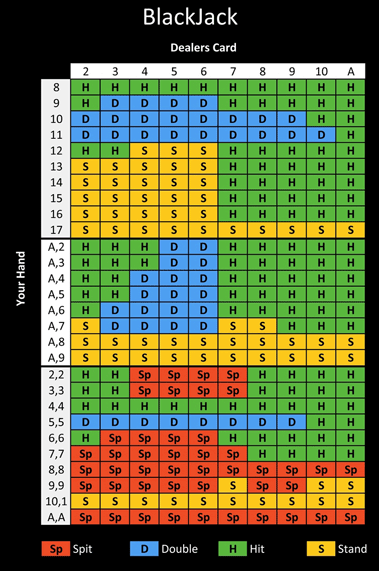I confirm, that I am over 18.
Blackjack – one of the most popular card games in casinos around the world and at the online casinos.
The great popularity of the game is caused by simple rules, speed of play and the most simple strategy of counting cards. Nevertheless, the popularity of the game won at once. Gambling houses of the United States had to promote an interest in playing different kinds of bonuses and a variety of rules of blackjack.
It is believed that the predecessor of this game was a card game «vingt-et-un» («twenty-one”), which appeared in the French gambling establishments around the XIX century.
Here are some featured casinos online providing blackjack online casino bonuses.
Also you have a great offer to play Live blackjack with real live dealer, supported casinos online you can find in Live Dealer Casino page.
Blackjack Strategy Chart
Using of that blackjack strategy chart will help you a lot in your and makes your play blacjkjack online more comfortable.
Blackjack rules
Mistakenly believed that the goal is to score as many points, but no more than 21. In fact, goal of the game – to beat the dealer.
Play from one to eight decks. Due to the fact that the probability of a combination of blackjack with a larger number of decks below, the player’s advantage decreases with increasing number of decks.
The values of the points of each card from two to ten – respectively from 2 to 10, with an ace – or a 11 (11 until the total amount of not more than 21, then 1), the so-called images (King, Queen, Jack) – 10.
If the player and dealer number of points equal to the hands, such a situation is called a Push. In this situation, all remain at their rates, no one wins and no loses. Although various casinos can be exceptions, and under “Push” wins the casino.
Players place their bets, placing chips in the appropriate fields the table. Bets are placed before the cards. After the first cards are dealt, players are prohibited from betting and touch their chips.
The dealer deals cards (usually one or two decks of cards, but most of the shoe containing four or more decks): two cards to each player, currently giving away a card (in the U.S. decided to distribute the dealer two cards, one of which is open and the other – closed, that is on the table face down). All maps open at once (you can see and the dealer and the player).
If the player immediately after the distribution of 21 points (that is, a player 10 or an ace and an ace and a picture), this situation is called a blackjack. In this case, the player once the win 3 to 2 (ie 1.5 times his bet). The exception is when the dealer’s first card (open) catches 10, picture or ace. In this case, it is likely that the dealer has blackjack also, so the player with blackjack offered a prize to take a 1 to 1 (only if the dealer’s first card – an ace), or wait until the end of the Kohn game (and if the dealer does not have blackjack, get the win 3 to 2)
Next, the players who do not have a blackjack are offered a choice or take another card (in which case the player must tell the dealer “map” or “more”), or remain under the maps (and the total points), which in his hand ( In this case, the player must say the dealer is “sufficient” or “enough”).
As a general rule, if a player after taking a new card in the amount of turns 21, the dealer did not ask him any more and moves to the next player.
If a player after taking a new card the total score exceeds 21, the situation is called “enumeration.” The dealer says “a lot” and removes the player’s bet in favor of the casino.
If the dealer in the first two cards typed 21 (Blackjack), all players (except those who have too blackjack), they lose. Those with a blackjack, remain in their rates if they have not chosen to take advantage of 1 to 1 or if you do not insure our combination of blackjack.
In some cases, depending on what cards a player’s hand, the dealer can offer them additional options (see below).
Once all players have completed the draw cards, the dealer says “myself” and handing out cards to himself. The general rule Blackjack is that the dealer must stop, gets 17 points or higher, and is obliged to take, until they reach (even if not all migrated less points). Different casinos will vary generally, should the dealer to stay in the situation, if he has an ace and a six (ie, 7 or 17 points on the hand). Usually it is usually written on the board.
Blackjack Card counting
Is usually done a few hands of a single deck (or decks set – shoes). That is, the cards do not come back every once in a pack and it does not mix. Therefore, unlike most other casino games, the probability of the outcome of the game of blackjack is dependent on previous games. Player, a leading card counting emerged, can greatly increase your chances, and even, under certain conditions, to secure an advantage in the game. The strategy is to make small bets when the probability of winning is low and higher when the odds of winning are high.
Security Service casinos are trying to identify the players involved in counting the cards and, if local laws permit, forbid them access to the casino. We are taking other measures such as increasing the number of decks in shuze, cutting the deck, it is forbidden to raise (increase) their bid. In addition, the casino employees are free to count cards and shuffle the deck, when the probability of winning players is too large.
This technique became the basis for the game story of the film “21”, inspired by the reality of events.
The film used a system of counting the “Plus-minus.”
The system proposed in 1963 by Harvey Dabner As in the accounts of ten, each card coming out of the pack, given its numerical value:
Cards |
Num. values |
2, 3, 4, 5, 6 |
+1 |
7, 8, 9 |
0 |
10, J, Q, K, A |
-1 |
It is easy to verify that the sum of values in a single 52-card deck is zero. The same is true of the “big deck”. Systems with this property are sometimes called balanced.
As the exit cards from the deck watching the current account. Sevens, eights and nines are ignored, the output of high cards (tens and aces) leads to a decrease in accounts junior (from two to six) – to increase the bill. The system of “Plus-minus”, like any well-balanced system, has a very simple property: a positive analysis, the chances of players increases, a negative – decrease. The higher the score, the higher your expected return.
But the question remains open: to what extent change your chances, depending on the account? At what point to begin to raise rates? It turns out that the current account is not an assistant, he does not answer. To get an idea of his chances, we use the so-called real account (sometimes called the true score).
The real expense is obtained by dividing the current account for the number of remaining decks in the game. For example, the game came from one deck, the current account is equal to 12. Divide it by five (the number of remaining decks) and get a real account, equal to 2.4.
Since we are interested in counting the number of decks can be difficult. Especially, the number is in general fractional. The simplest way to estimate – to look at the pile of cards won back, lying on the table to the right of the dealer. Having estimated the number of decks that came out of the game, count the number of decks remaining is not difficult. And if you sit close to the clogs, where the dealer draws the next card, you can look right into this box.
All this, of course, requires serious diligent training. We must learn at least a rough estimate the number of packs contained in a stack of cards to get used to the faultless management of current accounts. And both need to try at home. And do not spare the time for it: a game for the wrong score can lead to disastrous consequences. If you are not confident, calmer completely forget about all sorts of calculations, and always play the “flat kusham”, acting on a common basic strategy. But let’s assume all of the woods – an oral account became commonplace, with a stack of cards you are accustomed. Let’s go back to the standard Black Jack, and see how changing your chances depending on the actual bill.
-10 |
-4.79% |
10 |
7.39% |
-9 |
-4.49% |
9 |
6.51% |
-8 |
-4.15% |
8 |
5.65% |
-7 |
-3.75% |
7 |
4.83% |
-6 |
-3.30% |
6 |
4.07% |
-5 |
-2.80% |
5 |
3.32% |
-4 |
-2.26% |
4 |
2.64% |
-3 |
-1.71% |
3 |
1.98% |
-2 |
-1.12% |
2 |
1.36% |
-1 |
-0.53% |
1 |
0.73% |
0 |
0.09% |
Obviously, with a negative account balance (-2 or lower) should reduce the rate or at all by not playing. Conversely, if the account is positive (+2 or higher) rates of time increase. However, it all depends on your temperament.
As we saw in the previous chapter, for any deviation from zero accounts, the hypothesis of uniformity breaks down, and this makes it necessary to correct basic strategy. The higher the real score, the more careful we are gaining additional cards, the more we give “compensation” and use the new features with a doubling rate or the separation of cards.
Does the system “plus-minus” any disadvantages? Of course it does. None of our results in this system is not intended for high reliability. We already know that from the perspective of a player scores an ace is stronger, and five “bad” rather than two. However, during the account is no difference between these cards, we did not. Meanwhile, the real positive score obtained as a result of exiting the game of fives, a much more valuable than the same account was due to the won back deuces. The same parallel can be drawn between the tens and aces. Moments when the odds are really the player reaches a maximum, is not always caught. Conversely, sometimes it happens that the system sends the wrong signals to the player.
Whatever the real score, in the “plus-minus,” we have to assume that the probability of occurrence of two – the same as that of the five, and ten will come in four times more likely than an ace. With regard to medium-sized cards (seven, eight, nine), then, in general, we were not paying attention. So you have to bear in mind that regardless of the actual account the probability of occurrence of each such chart remains the same – 1 / 13. All this is little in common with our original hypothesis of uniformity.
Trying to neutralize all these shortcomings, the authors of systems does not stint on the new inventions and constantly moved on. The essence of the system still relied on a real account and remain unchanged. But the cards that fall from the deck, were assigned to other, more (or less!) Appropriate numerical values. The effectiveness of the developed systems are sometimes increased, with the simplicity of the situation was much worse. As an example, let’s look at a relatively simple system sufficiently close to the “Plus-minus.”
The system of “halves” This system is described in his remarkable book Stanford Wong (English) “Professional Blackjack”. Here are the numeric values are assigned cards that fall from the deck:
Cards |
Num. values |
2,3,4,1 |
+ 0,5 |
5 |
+1,5 |
6 |
+1 |
7 |
+0,5 |
8 |
0 |
9 |
-0,5 |
10, J, Q, K, A |
-1 |
If you do not like halves, we can multiply all values by two and move on to whole numbers. Although this will have to work with redoubled real account. As in the “plus-minus”, the expected payoff depends on the player’s Real account:
-10 |
-4.63% |
10 |
7.24% |
-9 |
-4.33% |
9 |
6.39% |
-8 |
-4.01% |
8 |
5.56% |
-7 |
-3.64% |
7 |
4.78% |
-6 |
-3.20% |
6 |
4.01% |
-5 |
-2.73% |
5 |
3.28% |
-4 |
-2.20% |
4 |
2.61% |
-3 |
-1.67% |
3 |
1.96% |
-2 |
-1.10% |
2 |
1.34% |
-1 |
-0.52% |
1 |
0.72% |
0 |
0.09% |
It is almost the same as we saw in the previous section. The point, however, is not it. The numerical values assigned to cards in this case, more accurate, so the system becomes more efficient and, most importantly, reliable. Signals that it sends to the player, in most cases, correct, and they can be treated with a greater degree of confidence. These percentages are more reliable than ever before. Although deviations from these averages are very frequent and close, compared to the system “plus-minus” they are small.
On the other hand, an oral account of the halves of the much more complicated, and mistakes are usually very expensive. He started his career with the counter of this system we do not recommend.
Both systems – “Plus-minus” and “half” – designed to detect situations where the chances of the player are particularly high. You may want to combine all this with a competent approach to insurance. In principle, it is possible to double-counting, tracking the real account of one of these systems and simultaneously considering tens. But to work with double-counting is very, very difficult. Even if that works out, you’ll quickly get tired and, at best, leave the casino with a headache. In the worst case – you’ll start to make mistakes without noticing, and leave the casino will have to because the game is not on that. Venture on a double bill can only experienced player at the table acting at the level of a professional.
However, one recommendation we give. Working with a system of “Plus-minus,” you can go for insurance if the actual expense exceeds 3.33. In the “halves” is the threshold a little bit more – 3.67. Of course, by their accuracy, these criteria are inferior to what we would have, counting only ten.
For a nice single player (no collusion), and rational system of “random card counting.”
Random card counting does not require the player to limit the concentration or mathematical calculations during the game. You already know that a lot of ten-pack of cards that are advantageous for the player. All you need now – it’s just sometimes keep track of what cards go into a retreat. For example, if you play multiple packs and after a series of hands took very few aces or pictures, so you have a good chance to win the next hand. Increase your bid.
Just with a marked absence of high cards, increase your next bet, and your chances of winning the overall bit, but will increase.
We wish you to become a pro and start to play blackjack online, dont forget to use blackjack online casino bonuses provided by casinos online and make a big cash today!










